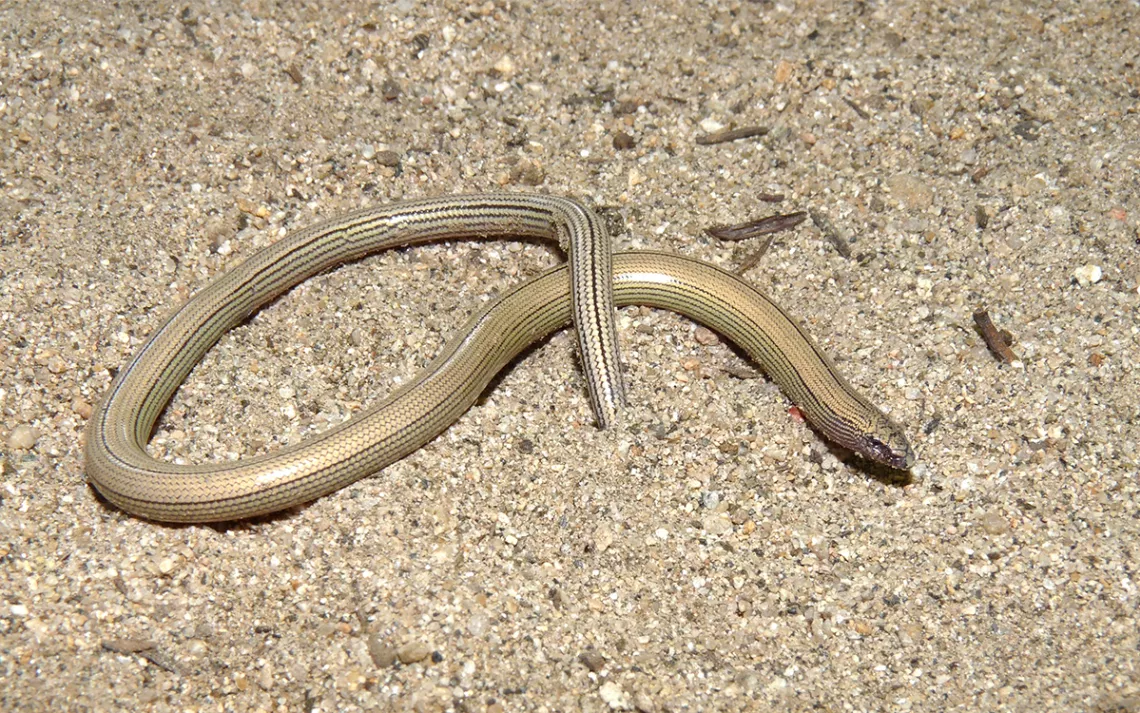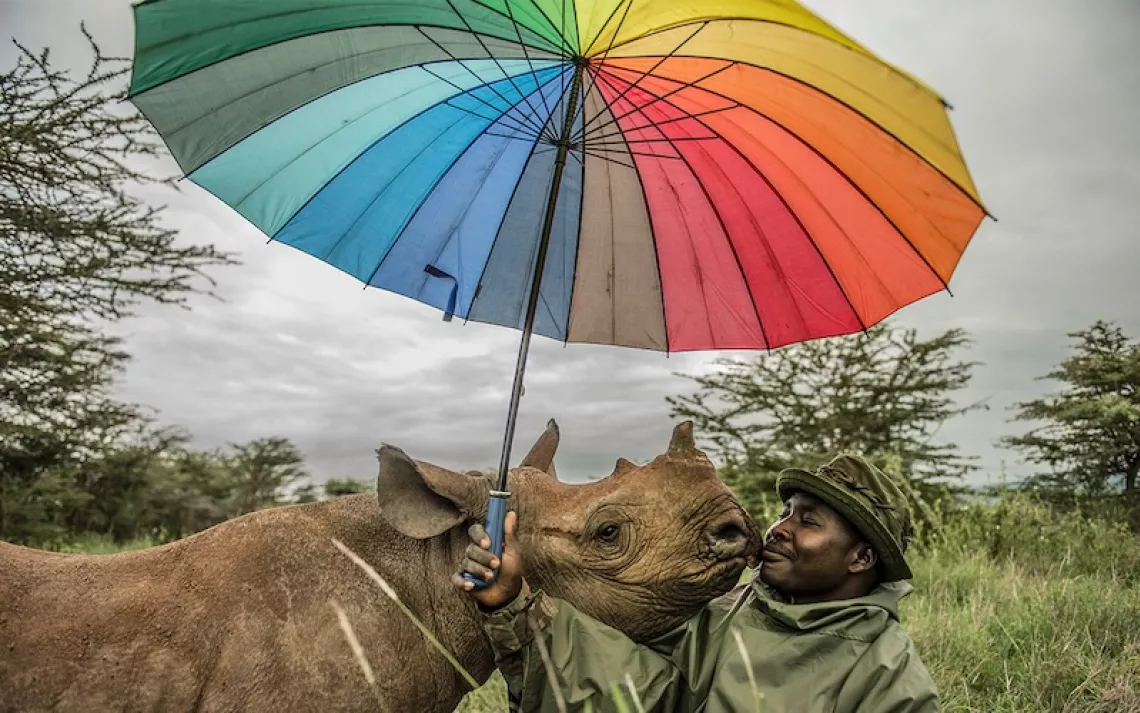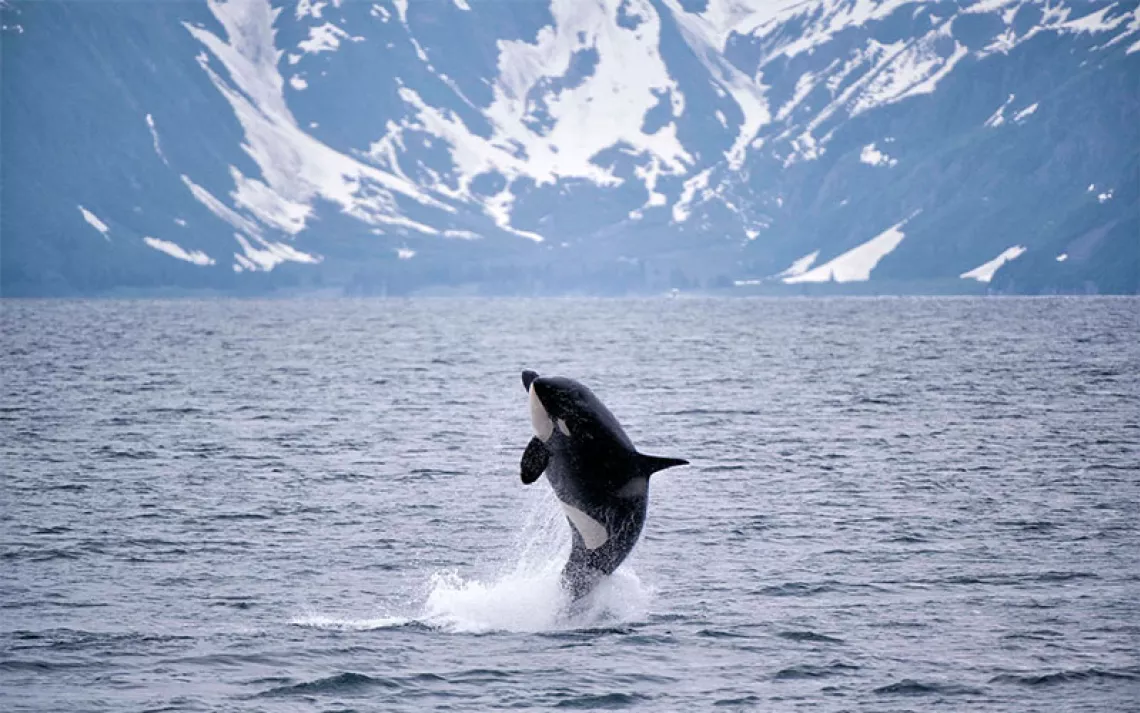A Rare Legless Lizard Could Stop Oil Drilling in Its Tracks
The legal status of the Temblor legless lizard threatens industry’s free rein

The Temblor legless lizard. | Photo by Alex Krohn
Resting in the desert sand along the east side of California’s Temblor Mountains, one legless lizard stands alone in potentially halting 31 active oil fields from production.
This rare, endemic reptile, the Temblor legless lizard resides in a small patch of about 1,070 square miles of desert scrub and grassland within Kern and Fresno Counties. There, it has only been found in five locations, four of which are on or next to oil and gas fields with oil wells mostly owned by Chevron and Aera Energy. Currently, the vast majority of the lizard’s range is open to, or already contains, oil and gas development. But a proposal to list the lizard as endangered could change the trajectory of the region.
An adult male is the size of a pencil. Its greenish-gray scales and thin blackish-brown strips are more reminiscent of a snake, though it has moveable eyelids and a detachable tail, used for escaping predators when it has been (literally) caught by its tail. Legless lizards show promise in surviving a future shaped by climate change because they can withstand a wide range of temperatures; the Temblor legless lizard will move closer to the surface if it needs more warmth or will burrow deeper if it’s getting too hot—they are the only sand swimming specialist in the state.
“A lot of people would just think it’s some sort of weird-looking little worm,” said Ted Papenfuss, a researcher at the University of California, Berkeley’s Museum of Vertebrate Zoology and the foremost expert on this species. “They're so small, unless you get down to look at it carefully, you wouldn't really know what it was.”
Your luck of ever finding one is slim—they are active around dusk and dawn and burrow beneath the soil, only coming up to feed on beetles and flies. Papenfuss has spent the past two decades studying them. He said sometimes it can take years of searching—once every few months—just to find one. Because of this, experts don’t have clear population estimates, but they are certain of one thing: Population sizes have declined due to habitat fragmentation from oil and gas drilling.
Lizards in Kern County in particular are in danger. The county is attempting to approve an oil and gas permitting ordinance that would not require further environmental review or public notice for new oil and gas projects, allowing a single environmental impact statement for more than 40,000 new oil and gas projects over the next decades. In 2021, the Center for Biological Diversity (CBD), an environmental advocacy group, sued Kern County over the ordinance. Judges have told the county to redo its environmental impact statement for oil and gas permitting because it failed to address serious environmental harms to land, air, and water as required by the California Environmental Quality Act.
Still, since 2019, 1,184 new oil and gas permits have been approved for Kern County’s Midway-Sunset and McKittrick oil fields, both sites where the Temblor legless lizard has already been located. This is on top of the approximate 27,000 active or idle wells already on those fields. Kern County produces 70 percent of California’s oil and is responsible for 16,000 jobs.
“This lizard is incredible, and they are really unique,” said Shaye Wolf, the climate science director at CBD. When Wolf was looking into ways to protect this species, she overlapped maps of the existing habitat range with oil and gas activity and with unprotected land open to oil and gas development. She found that 31 oil fields overlapped the lizard’s range and that 98 percent of the lizard’s range is available to new oil and gas permits and leases. In November 2021, she decided to officially petition to list the lizard under the California Endangered Species Act as either threatened or endangered due to oil and gas development and habitat destruction.
An official listing under CESA would mean that before companies want to develop or drill, they have to survey for the lizard first. That takes several years to do accurately and adequately under the law, and time is money. If the companies find the lizard in the area, they have to come up with a mitigation plan.
Wolf hopes that a permanent listing will push the state to stop approving new oil and gas permits in the area and phase out existing projects. Ideally, she said, state agencies would go even further than the CESA requires and would acquire and protect the lizard’s critical habitat. The petition also notes that a permanent listing would be in line with Gavin Newsom’s plan to ban fracking permits by 2024, and phase out oil drilling by 2045. While this plan mostly focuses on carbon neutrality, it does cite potential human health benefits as well.
Seven months after CBD’s petition, in June 2022, the lizard was determined a candidate species, meaning permanent listing might be warranted. Under CESA, the legless lizard is granted full protections under the law until a final vote is held, which means no new oil and gas development within its range—including at the 31 active oil fields—can move forward without conducting a survey for the species. Advocates and oil giants wait for a final determination on the lizard’s fate, expected around January 2024.
Papenfuss said oil companies have been very interested in learning where the lizard is not located within their 1,070-square-mile range and have approved permits for him to survey for lizards on oil-producing land. One possible mitigation effort if the lizards are found, he said, is to fence off the bushes near where the lizards are found, so tractors don’t run over them and compact the soil.
Spills from oil and produced water (a toxic mix of water and hazardous chemicals that is a byproduct of oil production) are also a major concern for ecosystem and lizard heath, and fencing off bushes cannot prevent those. Since 2019, there have been 20 “surface expression” oil spills—oil and produced water forced to the surface by steam—within the lizard’s habitat. Two are still active, meaning they haven’t been cleaned up yet. In 2019, Chevron was fined $2.7 million for a surface expression oil spill in Kern County, which oozed 1.3 million gallons into the surrounding environment.
According to the CBD petition, oil spills entomb wildlife as the oil rises through the soil. If the lizards aren’t killed by the initial spill, they often are in the clean-up, which requires digging up several feet of soil drenched with oil. “The process of cleaning up an oil spill … could easily wipe out an entire legless lizard population,” Wolf writes in the petition.
Papenfuss said that the breeding cycle is a challenge because females don’t mature until they are three or four years old and on average will only have two live young. This is compounded with the stress of drought. He estimated that starting around 2019, after three years of drought, around 90 percent of the population died off. With a longer breeding cycle, it could take years for populations to bounce back.
The California Fish and Game Commission—a group of five individuals appointed by Governor Newsom—has the final say on if, and under what category, to list the lizard. The California Department of Fish and Wildlife was granted a six-month extension to submit their status report, and the commission will make a final decision at the next regularly scheduled meeting after the January 2024 deadline.
Currently, there isn’t opposition to listing from the oil companies, according to Papenfuss, who attended the Fish and Game Commission hearing on the petition in June. “As far as I can tell, there is no organized opposition to making it permanent, which is a little bit surprising,” he said.
But Wolf expects pushback from the oil giants when the commission is closer to a final vote on permanent listing, mainly because of the time and effort it would require from them. Chevron and Aera Energy representatives did not respond to requests for comment.
If the Temblor legless lizard is listed permanently, advocates hope it will protect its habitat from new oil endeavors—saving both the lizard and nearby communities and serving as an example of possibility for more species currently harmed by oil. “Oil and gas drilling needs to be stopped to protect the lizard, our communities, and the climate,” Wolf said. “We are all connected: When lizard habitat is being destroyed, that harms us as well.”
 The Magazine of The Sierra Club
The Magazine of The Sierra Club







